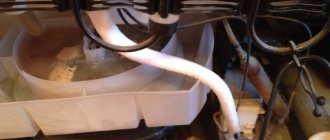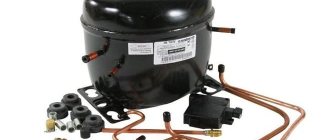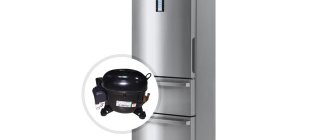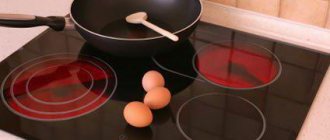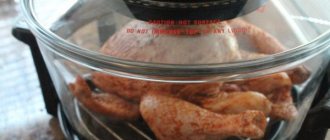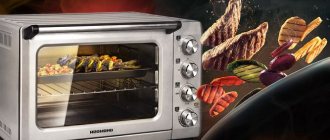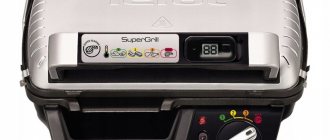Description of linear refrigerator compressor
When we close the refrigerator door, we hear a characteristic noise made by its operation.
When the compressor starts working, it creates a pressure difference inside the chambers. During operation, it cools the refrigerator compartments, removing heat by compressing and pumping the refrigerant. It transfers heat from the internal chambers to the outside, thereby cooling them. The linear type of equipment itself is a small device that operates using an internal piston driven by electricity. It is not big and takes up little space.
The entire mechanism is well hidden under its box. The design provides special holes for fastening to the machine body.
What is a linear refrigerator compressor used for?
A linear compressor, as we noted earlier, creates a pressure difference inside the refrigerator. Depending on the type of equipment, they are divided into several groups:
- screw type;
- piston type;
- rotational;
- centrifugal;
- spiral type.
Each type of equipment has both positive and negative sides. But their purpose is one, to transfer heat from the internal chambers to the outside. It should be noted that heat transfer from the camera may differ depending on the type of camera. It's no secret that the temperature of the freezer is different from the storage chamber, therefore, heat transfer inside it is carried out more intensively.
Recommendations
- Before choosing new appliances for your home, you need to find out the following points (if the inscriptions are worn out, coded or difficult to read, it is recommended to contact a specialist): what type of refrigerant is used - this information is indicated by the manufacturers in the instructions;
- the power of the device must correspond to the parameters from the passport or the label installed on the case;
- characteristics of the electrical network used;
- type of equipment;
- type of cooling system;
Linear compressor is noisy but just as durable
Watch a video about a refrigerator with an inverter compressor
How does a linear compressor work on a refrigerator?
We have looked at the operation of the linear model on surfaces, now we will consider in more detail the principle of operation depending on its type. Let's start in order:
- Screw type compressor , for this type of design a screw part is used, which ensures the circulation of refrigerant throughout the entire structure. During operation, the screw helps create high pressure inside the system.
- Electricity is supplied to a special rotor connected to the piston using a special connecting rod. The piston, in the process of translational movements, creates pressure inside the system, which allows for more efficient cooling of the system.
- For rotary type operation, a special rotor is used , which drives an electric motor. When the rotor begins to rotate, the eccentric flows to the inner surface of the cylinder. Where it compresses the refrigerant gas and pushes it out through the release valve.
- Centrifugal-type equipment is a system that operates on the principle of compressing a gaseous medium using a rotor with a shaft. The rotor has special wheels that are located symmetrically to each other. When the wheels with blades rotate, the gas begins to move from the center of the wheels to the edge. Then the gas is compressed, acquiring inertia, and begins further movement through the system. This process helps the refrigerator operate and maintain the optimal temperature.
- When operating spiral-type equipment , the refrigerant is compressed in the space between two spirals. One of them stands, moves forward, and the second rotates around it. It is important to note that the rotation has a non-standard trajectory; when the engine operates, which drives the movable spiral, it will mix along the walls of the first spiral, sliding along the oil film. The point of contact shifts from the edge of the spiral to the center, which facilitates the absorption of the substance. High gas pressure is achieved in the center of the equipment, and then the gas moves through the discharge line throughout the system.
Depending on its type, the principles of operation are slightly different, but despite this, all types of linear compressors are designed for one specific purpose, to regulate the pressure in the refrigerator chambers and maintain the temperature regime.
In addition to the linear type of compressor, there is also an inverter type, which is also very popular; below we will take a closer look at their differences.
Linear Compressor Operational Problems and Corrections/Operating Instructions Compressor Department LG Electronics|Digital Instrument Company. 1. Basic information. 1. Contents. 1. Main information. 2. External view 3. Internal view (diagram) 4. Linear wiring diagram 5. Diagram for solving simple problems 6. Sections 1.2 - troubleshooting 7. Warnings Appendix 1: how to check the serviceability of the compressor, 1.2. Appendix 2: How to connect the compressor Appendix 3: Compressor housing and wiring Appendix 4: Compressor/controller identification Appendix 5: Line protection function Appendix 6: Operating manual for R600a - 1,2,3,4. 2. Application. Operating problems and their correction/operating instructions are designed only for the following models:
| Model | Refrigerant | Application |
| FA88NAET | R600a | LBP(LowBackPressure) |
| FA102NBET | R600a | LBP(LowBackPressure) |
Information on use is posted in the main catalog on the page www.lge.com 2. Appearance
| Isometric projection | Side view |
3. Internal view (diagram)
1. List: 1. Compressor 2. Safety terminal 3. Sealing terminal 4. Safety device (grounding) 5. Safety device (power cable) 6. Housing, PWB (bottom) 7. PCB panel 8. Housing, label 9. Housing, PWB (top) 10. Housing, PWB (front) 11. Lock, combination stopper (input) 12. Lock, combination stopper (output) 13. 14mm fastening bolt (1-3) compressor parts ( 3-13) engine parts Assembled
4. Electrical diagram of a linear compressor
5. Scheme for solving simple problems
6. Troubleshooting
| PROBLEM | № | POSSIBLE REASON | CORRECTION | |
| 1. The compressor does not turn on and does not make a sound | 1.1 | Cable connection error | ||
| 1.1.1 | Error in the power supply cable to the motor | Check and correct it (according to Appendix 2) | ||
| 1.1.2 | Error in cable between motor and compressor | |||
| 1.1.3 | Communication cable disconnected | |||
| 1.1.4 | The cable between the motor and the capacitor is disconnected | |||
| 1.2 | Compressor problems | |||
| 1.2.1 | The cable has no contact between the motor and the sealed terminal | Check and fix it (according to app 1.6) | ||
| 1.3 | Engine failure (no energy supplied to the compressor) | |||
| 1.3.1 Phase gone | Replace them and test (if other parts are ok) | |||
| 1.3.2 Circuit error of PCB or its components | ||||
| 1.4 | Error signal from the refrigerator controller | |||
| 1.4.1 No turn-on signal from the refrigerator controller | Check and fix it | |||
| 1.5 | Compressor protection system is working | |||
| 1.5.1 Abnormal frequency (below 47 hertz or above 53 hertz) | Check the frequency (according to Appendix 4) | |||
| 2. The compressor does not turn on, but makes noise | 2.1 | Cable connection error | ||
| 2.1.1 Cables are not connected correctly | Check and correct it (according to Appendix 2) | |||
| 2.2 | Compressor problems | |||
| 2.2.1 Moving part fixed | Check and fix it (according to app 1.6) | |||
| 2.2.2 The main body was damaged | ||||
| 3. The compressor turns on and runs, but only starts the “short circuit”. | 3.1 | Compressor protection system is working | ||
| 3.1.1 Operation under current overload conditions (at 2.1A(RMS) for more than 10 seconds) | Wait 7 minutes. Or turn it on and off. If it happens again, check whether the compressor and operating cycle are normal. | |||
| 3.1.2 Operating under overvoltage conditions (below 160 volts or above 300 volts) | Wait 7 minutes. Or turn it on and off (in accordance with Appendix 5) | |||
| 3.1.3 Operating under conditions of sudden increase or decrease in voltage (approximately +- 15 volts) | ||||
| 3.2 | Capacitor error | |||
| 3.2.1 The starting capacitor does not perform its functions | Check and fix it | |||
| 3.3 | Error signal from the refrigerator controller | |||
| 3.3.1 Incorrect or randomly illuminated power-on signal from the refrigerator controller | Check and fix it | |||
| 4. The device operates without interruption | 4.1 | Compressor problems | ||
| 4.1.1 Low level of cold due to leakage in the compressor | Check and fix it (according to app 1.6) | |||
| 4.2 | Capacitor error | |||
| 4.2.1 Unsuitable capacitor | Check and fix it | |||
| 4.3 | Error signal from refrigerator PCB | |||
| 4.3.1 Long power-on signal from the refrigerator controller | Check and fix it | |||
| 4.4 | Hardware Cycle Problems | |||
| 4.4.1 Low refrigerant level | Fix the leak and add refrigerant | |||
| 4.4.2 Circuit leakage | ||||
| 4.5 | Engine failure | |||
| 4.5.1 Unstable operation of the communication port | Check and fix it | |||
| 4.6 | Cable connection error | |||
| 4.6.1 Cables between motor and compressor are not connected correctly | Check and correct it (according to Appendix 2) | |||
| 5. Abnormal noise | 5.1 | Compressor noise | ||
| 5.1.1 Parts have fallen off the fastenings, or the position on the stand is unstable | Check and secure loose | |||
| 5.1.2 The main body was damaged | Check and fix it | |||
| 5.2 | Engine noise | |||
| 5.2.1 Parts have fallen off the fastenings, or the position on the stand is unstable | Check and secure loose | |||
| 5.2.2 Lost wire connections | ||||
| 5.3 | Radiator problems | |||
| 5.3.1 Radiator pipe vibration | Check and secure loose | |||
| 5.3.2 Motor gets hot | Check and fix motor fan | |||
7. Attention.
| Please use only refrigerant/lube oil/electrical components recommended by the compressor manufacturer and follow the manufacturer's instructions to avoid explosion, fire and electrical injury. This warning must be systematically brought to the attention of the end owner and workshop personnel. |
| Electric Shock Hazard The compressor must be grounded if power is supplied to the motor or compressor. Be sure the compressor is unplugged before attempting any repairs. Ensure that the protective cover is in optimal position when power is supplied to the motor or compressor. |
| Explosions or Fire Carefully remove refrigerant from compressor before extinguishing. Do not pump air or turn on the compressor if there is a vacuum inside. Wear safety glasses during extinguishing operations. |
| Risk of Burns Do not touch the compressor with bare hands while it is running or immediately after stopping. |
8. Appendix 1. How to check the serviceability of the compressor - 1 How to check the serviceability of a linear compressor If any problems arise during the operation of the compressor, you should check the serviceability of the compressor as follows:
1. Checking the serviceability of the compressor by measuring resistance. Method 1.
Measure the resistance between the two poles of the sealed terminal (1 and 2 in the figure) using a multi-tester. (Performed a few minutes after the current is turned off) Case 1-1. If the readings are within the normal resistance range (see table at the bottom of the page), then the compressor is working. Case 1-2. If the measurement shows that the resistance is more than a few megohms or "Infinite", this means that the wire is not connected to the device. Case 1-3. If the measurement shows very little resistance, it means there is a short circuit somewhere in the device. Table of normal resistance ranges (at ambient temperature +23°C)
| Normal mode | Safe mode | |
| FA88NAET | 14 ~ 15.5 ohm | 17 ~ 19 ohms |
| FA102NBET | 9 ~ 10 ohm | 10 ~ 11 ohm |
*Depending on the ambient temperature and operating situation, the performance may vary slightly. 9. Appendix 1. How to check the serviceability of the compressor - 2 2. Checking the serviceability of the compressor by measuring resistance. Method 2. Measure the resistance between any point on the device body and any pole of the sealed terminal (3 in the figure on the right) using a multitester (leakage current measurement).
Case 2-1. If during measurement the device shows “Infinity”, then the compressor is working. Case 2-2. If the device does not show “Infinity” during measurement, this means that the insulation somewhere inside the case is damaged. 3. Checking the serviceability of the compressor by measuring temperature. Measure the surface temperature of the housing and drain pipe. Case 3-1. If the body surface temperature is significantly higher than the tube temperature, then the drain is blocked. In conclusion: If the compressor is working properly, check the wires. If the wires are OK, check the motor and replace it if faulty. *Important: 1. Measure the resistance only a few minutes after turning off the power to the refrigerator. 2. Be careful that the capacitor is connected to the electrical network even if the current is turned off. 10. Appendix 2. How to connect the compressor Enlarged image
11. Appendix 3. Controller housing and wiring Recommended installation diagram Input/output wires
*The installation diagram shown is the manufacturer's recommendation only (wires 1, 2 and 6 must be in their intended positions). The actual installation layout may be determined by the refrigerator manufacturer. 12. Appendix 4. Compressor identification
| 13. Appendix 4. Identification of the controller (motor) 14. Appendix 5 Linear Protection Function Diagram of Linear Protection Function The linear motor has triple protection against abnormal operating conditions. We usually call the protection function “trip”, for example, current trip for current, voltage trip for voltage. Linear protection function table
15. Appendix 6. Operating manual for linear compressor R600a – 1. Compressor operating ranges 1-1. Refrigerant Due to the highly flammable nature of the refrigerant used in R600a (Isobutane), safety equipment must be fully understood and installed accordingly before installing the compressor into a refrigeration cycle. 1-2. Evaporation Temperature Evaporation temperature should be maintained between -30°C (-22°F) and -5°C (-23°F). When the evaporation temperature becomes much lower than -30°C (-22°F), the motor will overheat and the temperature of the discharge gas and lubricating oil will rise, resulting in compressor failure.
If the evaporation temperature exceeds -5°C (-23°F), the unloading pressure will increase and, as a result, the compressor will be overloaded, which will increase wear on compressor parts and ultimately reduce compressor life. 1-3. Condensation/Compression Temperature Condensation temperature and pressure during continuous operation should not exceed 60°C (140°F) and 7.82 kg/cm2 G(111psig), and at a single peak load these values should not exceed 70°C (158° F) and 10.1 kg/cm2 G(143psig) at an ambient temperature of 43°C (110°F). When the condensing temperature exceeds 60°C, this may have a negative effect on compressor performance and energy consumption in the system. 16. Appendix 6. Operating manual for linear compressor R600a – 2. 1-4. Engine Temperature Engine cooling temperature, when the ambient temperature is 43 degrees Celsius (110 Fahrenheit), should be lower than 120 degrees Celsius (240 Fahrenheit). If the temperature exceeds these values, the motor will operate in overload mode, and this will greatly reduce the life of the motor. The cooling temperature is calculated using a cooling resistance diagram, an example is in the table on the right. After the compressor stops, the resistance should be immediately measured and as a result, the exact cooling temperature of the engine will be obtained.
1-5. Discharge Gas Temperature Discharge gas temperature measured approximately 50 mm from the compressor surface at an ambient temperature of 43 degrees Celsius (110 Fahrenheit) and must be maintained within 120 degrees Celsius (248 Fahrenheit) to avoid thermal decomposition of the oil and ensure operation compressor for a long time. If the temperature exceeds this mark, harmful sediment will collect on the periphery of the valve. 1-6. Compressor Case Temperature If the engine cooling temperature and discharge gas temperature are kept within the designated limits, the compressor case temperature is not controlled accurately. When necessary, the temperature is measured at the top of the compressor housing. 1-7. Suction Gas Temperature Suction gas temperature is measured at a distance of 150 mm from the compressor surface and should be within + - 5 degrees Celsius of the ambient temperature. 17. Appendix 6. Operating manual for linear compressor R600a – 3 2. Connecting the compressor to the cooling system. 2-1. Supplying voltage. The connected voltage must be above 90 - 100% of the required voltage during start-up and during operation. If difficulties arise in providing such voltage, then LG will offer another, alternative compressor option. 2-2. Electrical Controller (Motor) The linear compressor must be controlled by an appropriate controller provided by LGE. The electrical controller is designed to control and protect the linear compressor. There are 2 safety circuits that are controlled by programs and devices in the engine to prevent any catastrophic situation in the compressor. As a protective function, if the connected voltage exceeds the required limit, the motor causes the compressor to stop for a second. As soon as the reason for the stop disappears, the compressor starts again without further pause. It is very important to have a meaningful technical conversation with the supplier in order to increase the control effect, because the motor must be configured accordingly, depending on the connected equipment. Especially if the linear compressor is to be used with a different type of equipment under test than the refrigeration circuit, it is necessary to use a different motor supplied by the supplier. 2-3. Compressor Electrical Components There is no need to use PTC and OLP in a linear compressor. The electrical controller works as a substitute for PTC and OLP. Only a working capacitor can be used with a linear compressor, it must be exactly as indicated in the technical description. 18. Appendix 6. Operating manual for linear compressor R600a – 4. 2-4. Changing the amount of cooling The engine makes it possible to control the piston stroke, which makes it possible to control the amount (volume) of cooling within 70 - 80% using the engine. 2-5. Number of refrigerant charges The number of refrigerant charges is recommended as a minimum. If the amount of refrigerant is higher or lower than recommended, it will cause a reduction in cooling capacity and may damage the compressor. If the refrigerant level changes, contact LG for recommendations. 2-6. Oil quantity The compressor is supplied to the consumer fully charged with oil. 3. Notes on controlling the cooling system and compressor. 3-1.When evacuating the entire circuit for air or any hazardous gas, do not contaminate the circuit, clean it completely. The coolant must be changed when the compressor power is turned off. 3-2. Every component of the cooling system must be kept clean. 3-3. The maximum amount of water in the cooling system must be controlled. The R600a models use exclusively XH-7 type (molecular sieve) desiccant, which is manufactured separately. Excess water leads to the production of acid or sediment, which can clog the capillary tube. 3-4. Due to the high fire hazard of R600a, the cooling system is well sealed to prevent unexpected leaks. 21. Appendix 6. Operating manual for linear compressor R600a – 5. 3-5. When the compressor is connected to the refrigeration system, pay attention to the following points. 1. Nitrogen is charged and sealed before the compressor has been released. The compressor should be handled with care to avoid damage during transportation or storage. 2. Once the rubber nozzle is removed, the compressor should be connected to the refrigeration system as quickly as possible. 3. The compressor must begin to be used within 6 months from the date of its release. 4. During transportation or installation, ensure that the compressor is in the correct position and do not drop it. 5. When the compressor is connected to the circuit, the surface near it must be cleaned to prevent debris from getting into the compressor. If debris, such as dust, does get inside the compressor, it may cause damage. Be careful not to allow contaminants to enter the compressor pipe. 6. Since the compressor is painted with epoxy paint, you can repaint it if the paint comes off due to an accident. 3-6. If the design of the compressor or parts of the compressor is changed, or if it is used for other purposes without the approval of LGE, please note that all responsibility for this lies with the user. |
Differences between linear and inverter refrigerator compressors
Unlike linear models, the inverter model does not heavily load the refrigerator systems; it does not need to be turned on to maintain the temperature regime and turned off every time, it simply works stably and smoothly.
This principle of operation loads the electrical network noticeably less and reduces the percentage of possible short circuits to a minimum. When you turn on the equipment, the inverter model quickly reaches the desired temperature and maintains it throughout the entire operating time. It practically does not turn off, but simply reduces the power of operation. It should be noted that power changes occur gradually and smoothly, without loading the system. As a result of such work, large fluctuations in the temperature of the chambers are not observed. Let's break down its advantages:
- due to the fact that there is no need to work at maximum power, the noise level becomes less;
- The service life of such a refrigerator is noticeably longer, due to the fact that there are no periodic switching cycles.
But, it would seem, why have refrigerators with an inverter system not yet squeezed out models with linear compressors? But not everything is so simple; these models also have weaknesses:
- the inverter model is more sensitive to voltage drops;
- the cost of such models is noticeably higher than that of refrigerators with linear compressors.
Refrigerator repair in Bishkek
Converting from an inverter compressor to a conventional start-stop compressor instead of a linear or BLDC.
Ceiling made of gypsum plasterboard: pros and cons
What if the compressor fails and the case is not covered by warranty!? For example, the refrigerator only worked for a couple of years and such a disaster happened... ((It has already reached the point that two years for LG refrigerators is often the death of the linear inverter compressor.
What is an inverter compressor?
For example, the cost of a new inverter compressor is incommensurate with the cost of a refrigerator, or there is no place to get it, buy it, or order it. A regular motor compressor costs about 3500-5000 soms (without installation) and they are always available for sale. It would seem that in this case it would be more expedient to install a conventional motor instead of an inverter one, but here the manufacturer protected itself from this. If you install a regular compressor, then there is simply nothing to control it; it will not work there. The inverter controller immediately recognizes that there are some problems with the motor-compressor and goes into error; with an error, the refrigerator may completely turn off or work in emergency mode. The electronic control module is designed to control only an inverter compressor; it will immediately give an error and nothing will work. You only need the original compressor, or replacing or converting the control module to a version that controls a conventional compressor.
Especially for such cases, we have developed a special “fake” simulator for installing a conventional compressor, instead of an inverter one, without any major modifications to the refrigerator (there is no interference in the operating logic of the control module or its replacement).
Inverter simulator HITACHI, LG
Photo of the installed decoy on the control module. Refrigerator LG GA-B429SECZ To install it, it is advisable to clear the space and turn off the power to the integrated inverter, as well as solder the power wires and the data exchange protocol wire.
Decoy for SAMSUNG refrigerators. Inverters: 459 and 814 In Samsung, the inverter is installed separately from the main board. To install it, just disconnect 3 chips from the inverter and connect them to the blende. All standard wiring and connectors are used.
SAMSUNG 757 inverter with additional power supply
Adapter for installing a conventional compressor instead of an EMBRACO inverter compressor (EMBRACO compressors are used on many brands of refrigerators, for example BOSCH, SIEMENS, HAIER, LIEBHERR)
Just like on SAMSUNG, native connectors and wires are used.
Its logical work consists of converting the signal output from the native control module into operation or stopping of a conventional compressor. And also an imitation of the feedback signal about the operation of the inverter compressor “feedback”, i.e. it sends a signal to the native controller “brain” that a native compressor is installed, so that it does not generate an error code about any malfunction with the compressor. A kind of deception of the native “brains”. The trick has been tested and successfully put into operation on some refrigerators. (For now only for some brands and models of refrigerators.) HITACHI, LG, SAMSUNG, SIEMENS, BOSCH, HAIER.
Examples:
Replacing the compressor of the LG GA-B499ZVCZ refrigerator from a linear inverter FMC088NAMA to a regular one from SECOP (made in Austria)
Replacing inverter BLDC and linear inverter compressors on LG refrigerators BMG089NHMV, BSA075NHMV, FC102NEM, FLC102NAMA FC124NAME, FC124NBMA, FC150NAMA, FMC088NAMA, FMA102NAMA
Replacing the Hitachi R-VG470PUN3 refrigerator compressor from an inverter CL1588-DA to a regular one from SECOP (made in Austria)
HITACHI refrigerator repair
Replacing inverter compressors on refrigerators HITACHI CL1588-DA CL1588DA WL16H10DAN CL1610-DL CL1610DL
HITACHI refrigerator repair
For all questions and to order decoys, write to whatsapp: +996550322144
Possible delivery by SDEK courier service in Russia and CIS countries
Opening hours: 9:00 to 18:00 (Sunday closed)
Contacts:
0550 322-144; 0312 894-615 (Vitaly)
Advantages of refrigerators with linear compressor
A refrigerator with linear equipment is more productive; its electromagnetic circuit can significantly reduce electricity losses during equipment operation.
Important! When operating this equipment, “direct current” circuits are used, which improves the energy saving class. This equipment has a quiet start system, which reduces the noise level and keeps it to a minimum. If we compare environmental indicators, this model is significantly ahead of the inverter model in many respects. And most importantly, its price is noticeably cheaper than its competitor, which is a strong argument in its favor.
Subscribe to our Social networks
Pros and cons of an inverter refrigeration system
Advantages of inverter devices:
- Economical consumption of energy resources. This makes it possible to save almost ten percent on energy bills. This figure may seem insignificant. With constant use and active operation in cooling mode, the difference is noticeable. There are equipment models that can reach a high economy class. Accordingly, their price is much higher.
- The equipment is completely safe for wiring. This can be explained by the absence of sharp transitions when turning the device on and off. The blades rotate smoothly, without unnecessary noise. Refrigerators with an inverter can last up to ten years without the intervention of repairmen.
- The equipment operates almost silently. Some discomfort will be noticeable only when the system is started for the first time. After this, no extraneous sounds should be noticeable. There are also no clicks.
- Constant temperature is maintained. This result is achieved due to the continuous operation of the equipment. The temperature will never rise above a certain level. Products last much longer.
Additional Information. Some inverter refrigerators have a more modern control system. This is especially true for smart refrigerators.
Some equipment models running on an inverter motor have the following disadvantages:
- The equipment is economical in terms of electricity, but you will have to spend a lot of money to purchase it. Modern technology has a corresponding price, which should be taken into account. At the same time, the purchase will be fully paid for by longevity and efficiency.
- Some types of engines are particularly sensitive to sudden temperature changes. It may be necessary to install additional controls on the electric meter. There are some refrigerator models that have a built-in system to ensure a smooth transition to standby mode in the event of low or high voltage.
